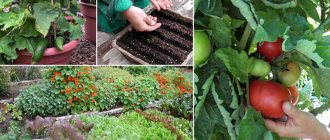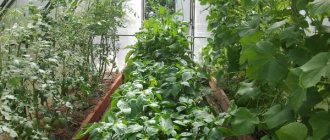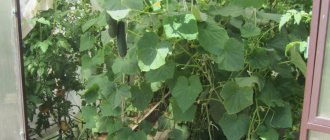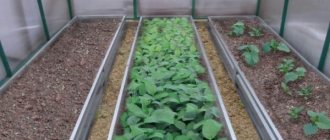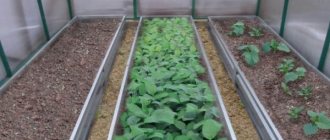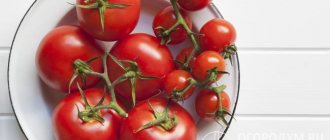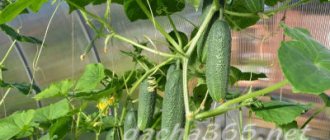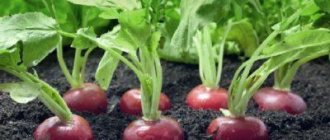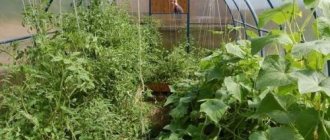Is it possible to plant these crops side by side?
Many gardeners do not recommend growing vegetable crops such as cucumbers and tomatoes in close proximity. Their incompatibility is quite obvious:
- The homeland of the cucumber is Ancient India. Like its historical relative, the cucumber prefers sunny, warm, but not very hot weather. However, it is very demanding on air and soil humidity. Therefore, this vegetable requires frequent watering. For cucumbers, constant ventilation and drafts, which are necessary for tomatoes, are detrimental.
- According to some sources, Peru is considered the birthplace of the tomato. This vegetable is very unpretentious to grow. Only, unlike cucumbers, he does not like frequent watering and abundant sun, preferring fresh air and diffused light. Otherwise, the tomato loses its exquisite taste.
What to consider?
To get a good harvest of tomatoes and cucumbers when planting together in a greenhouse, you need to take into account the following features of joint cultivation:
- The greenhouse should be high and wide enough. Sometimes a second entrance is made in it.
- The greenhouse should contain a large number of vents for drafts in the “tomato” section.
You also need to select certain varieties of crops:
- among cucumbers, these should be disease-resistant hybrids or varieties that are tolerant of coolness;
- For tomatoes, good tolerance to moisture and heat is a prerequisite.
It would be better to place the greenhouse in the direction from west to east. Thus, the southern side of the greenhouse will be well lit.
Is it possible to grow tomatoes in an apartment?
Of course, you can grow tomatoes in an apartment. You can grow them using container plant gardening techniques.
Tomato harvest on the window a month after sowing
Look around your apartment and find the best place to grow tomatoes. A bright balcony, loggia, or sunny window sill facing south or west is ideal. Choose standard varieties and hybrids, cherry tomatoes and early short varieties for harvesting on the balcony, since similar series have appeared in almost all large seed companies.
You can learn everything about growing tomatoes on a windowsill from our detailed article here >>>>>
The feasibility of joint planting
Growing tomatoes and cucumbers in one greenhouse is very troublesome and difficult. These vegetable crops are absolutely incompatible in their climatic requirements. Constant drafts and coolness can ruin the yield of cucumbers. While a tomato with high soil and air humidity may completely die.
But there are two undoubted advantages of joint cultivation:
- saving space and sufficient crop yield (although the latter will require some experience);
- As a rule, cucumbers and tomatoes have different diseases.
Needs of cucumbers
To get a large harvest of vegetables, certain conditions must be met:
- Cucumbers should be planted at 10-15 degrees Celsius.
- The plant and fruits develop better at 25-32 degrees Celsius.
- The growth of cucumbers stops if the air temperature is below 10 or above 40 degrees.
- Fruits stop developing at 35 degrees Celsius.
- The soil temperature may differ from the air temperature by no more than 2-3 degrees.
- Soil moisture should be at least 85-95 percent.
- Soil moisture should be 75-80 percent.
- In dry weather, cucumbers need to be watered frequently.
- It is not advisable to fertilize young inflorescences in the early stages of growth. It is also not recommended to use large amounts of fertilizer for cucumbers growing on sandy soils.
- The acidity of the soil should be neutral or slightly acidic.
Tomato needs
- Planting tomatoes is possible already at 8 degrees Celsius.
- The best temperature for the development of sprouts and fruits ranges from 18-25 degrees.
- Development slows down at temperatures below 15 and above 35 degrees Celsius.
- The tomato can withstand up to -1 degree cold.
- Air and soil humidity should be no higher than 45-60 percent.
- Vegetables need to be watered generously, but not more than 1-2 times a week.
- In the hottest weather, you can water up to 3 times a week.
- Tomatoes love a slight draft, but do not tolerate wind.
- The acidity of the soil, as for a cucumber, should be slightly acidic or neutral.
Long road to popularity
Any living organism, be it a plant or an animal, is endowed by nature with a certain genetic code that determines its properties and requirements for its habitat.
Selection work with seed material carried out over many decades has made it possible to change and improve the appearance and taste of vegetables.
But very rarely they give the opportunity to change their requirements for the growing environment, although some plants can adapt to changing conditions in nature through mutation processes.
Hot India with high humidity is the homeland of cucumber. It still grows wild in those places.
Images of cucumber were found on the frescoes of Ancient Egypt and Greek temples. Known in such ancient times in other countries, the vegetable in Russia was first mentioned in printed sources in the 16th century.
The cucumber supposedly came to us from East Asia, but surprisingly it caught our taste and became a truly national product.
Abundant harvests of cucumbers are grown in most parts of the country - in greenhouses and on the ground. And then, with love and effort, they prepare cucumbers for eating all year round.
Wild tomatoes were first discovered in South America during the expedition of Christopher Columbus, and their seeds were brought to Europe for their ornamental value. At home, tomato thickets were found on dry and ventilated mountain slopes. The climate of those places was ideal for tomatoes - soft, moderate, with rare heavy rains. The 24-hour temperature ranged from 20 to 25 degrees Celsius.
REFERENCE: In Holland, France and Germany, tomatoes were grown in the greenhouses of wealthy people and planted for decoration in gardens and near gazebos. Their fruits were considered poisonous. It was only in 1811 that the German Botanical Dictionary published information on its pages that tomatoes can be eaten.
Tomato seeds came to Russia under Catherine II, but only at the beginning of the 19th century they began to be grown in the southern regions of the country as an edible crop and good yields were obtained.
This is interesting: Dousing bucket for a bath
Combination conditions
The main condition for combined planting of vegetables is the need for zoning. Moreover, it is advisable to divide not only the perimeter of the greenhouse in order to be able to create a separate microclimate, but also the soil between the beds. This is necessary so that abundant moisture from watering the cucumbers does not reach the roots of the tomatoes. For planting in open ground, tomatoes should also be separated from cucumbers using:
- zucchini;
- corn;
- beets;
- grapes or any other “harmless” plant crop.
Is it possible to plant cucumbers in the place where tomatoes grew?
When planting vegetables, an important rule of crop rotation is to leave a three-year period between re-planting melons (cucumbers, squash and pumpkins) and nightshade crops (potatoes, tomatoes, eggplants and peppers). Ideally, different types of plants should not be grown within three years of each other. So if you want to grow tomatoes, potatoes, peppers and eggplants, you need to plant different areas at different times, constantly changing the combinations. When you combine tomatoes and cucumbers in the same space year after year, the same substances are washed out of the soil and the same disease-causing spores are introduced. Over time, you will lose in the quality and quantity of your harvest if you do not replace the soil and follow disease prevention measures.
Everything about growing cucumbers is waiting for you here >>>>>
Selection of varieties
For the joint cultivation of such different crops as tomato and cucumber, it is better to choose tomato varieties that are high-yielding, disease-resistant and do not require special care. Among the tomatoes it is.
Waterfall
Tall variety with bright orange fruits. Productivity can reach up to 8 kg.
Nastena
This variety is characterized by large, red, fleshy berries. This species is very disease resistant and easily tolerates high humidity and low temperatures.
Anastasia
A tall, mid-ripening variety has medium-sized red or burgundy fruits. Subject to proper care conditions, it produces about 12 kg of yield.
Crimson Giant
The variety is famous for its huge pink fruits. The species is resistant to diseases and pests.
Diabolic
It is distinguished by its high growth, up to 1.5 meters, and medium-sized elongated red fruits. This species practically does not get sick.
We invite you to watch a video about the Diabolic tomato variety:
Samara
An early ripe variety with bright red fruits that do not crack. More suitable for greenhouse cultivation.
Before planting seedlings, the soil should be watered with a solution of potassium permanganate.
Among cucumber varieties, they are distinguished by high yield.
Elegant
Tall early ripening species. Not suitable for canning.
Vyaznikovsky 37
One of the early ripening varieties. Resistant to various infections, including powdery mildew.
Farmer
A universal type that is suitable for both greenhouses and open planting. It matures for up to two months.
Lilliputian
A high-yielding variety that does not require frequent watering.
Firestarter
Famous for its high yield of up to 30 kg per square meter.
fontanel
As a rule, it produces high yields and is resistant to diseases. More suitable for a greenhouse.
Hermann
An early ripening variety with large, medium-sized, tuberous fruits. Tolerates early frosts well and is not susceptible to disease. This type has no bitterness.
How to sow correctly?
A successful harvest depends not only on compliance with all climatic conditions, but also on how to properly plant seedlings previously grown from seeds. Before this, you need to properly prepare the greenhouse:
- carry out complete disinfection (read more about how to treat tomato seeds before sowing in a separate material);
- prepare soil;
- at a level of 1-2 meters from the bed, pull the fishing line for a leash;
- form beds in the greenhouse about 40 cm high and about 90 cm wide.
- How to fertilize the beds.
You may be interested in looking at our materials about other methods of growing tomato seedlings: in twists, using peat tablets, without picking, and also in the Chinese way.
The technique of planting vegetables is not much different from each other. This happens according to this scheme:
- holes are dug in the beds, slightly larger than a seedling;
- a seedling with soil from a pot is planted in a hole;
- seedlings are planted at a distance of up to 50 cm from each other in a checkerboard pattern;
- then the seedlings are sprayed with a special solution against root rot.
Separation
You can divide the soil between the beds in the greenhouse using an iron sheet along the entire planting. This will help avoid water “flowing” when watering cucumbers to tomatoes. There is another way to divide the plot. To do this, you need to create three beds:
- The northern part of the greenhouse is suitable for cucumbers. It is the coolest and dampest.
- Planting tomatoes is optimal in the middle part, as it is best ventilated here.
- In the southern bed, where there is a lot of sun and warmth, you can plant any type of pepper (how to grow peppers and tomatoes together?).
Zoning
To create your own climate, which is required for these vegetables, you need to create an artificial barrier between them. You can stretch regular cling film between the beds from the soil level to the very top of the greenhouse. Before zoning the room, it is advisable to make another entrance on the opposite side of the greenhouse. This will allow you to easily move from one artificially created “compartment” of the greenhouse to another.
Hydrogel
Another way to avoid excess moisture getting into the tomatoes when watering cucumbers is to use a hydrogel that contains polymers. When wet, it absorbs liquid and expands greatly. Adding it to the soil when planting cucumbers will make caring for vegetables easier.
How to care in a greenhouse and in a garden bed - step-by-step instructions
With complete zoning of the greenhouse area, caring for tomatoes and cucumbers planted together is no different from usual. To get a good harvest of tomatoes, you should:
- for the first two weeks after planting, maintain a temperature regime of 20-22 degrees;
- if the sun is too active, the seedlings need to be slightly shaded;
- the first watering is carried out no earlier than 10 years after planting;
- Plants should be watered early in the morning or late in the evening;
- the water temperature should not differ from the soil temperature;
- water the tomato right to the root;
- after watering the vegetable, the greenhouse compartment needs to be ventilated;
- it is necessary to provide access for insects and bees to pollinate tomato seedlings.
Caring for cucumbers in the garden beds is quite simple; you only need to follow a few rules:
- young seedlings are watered with warm water, about 25 degrees;
- after watering, it is advisable to ventilate the greenhouse, avoiding drafts;
- when the first ovaries appear, the temperature in the greenhouse needs to be raised to 28 degrees Celsius;
- To prevent the plant from growing, pinching should be done in a timely manner.
Hydrogel - water substitute
This polymer crumb will help avoid frequent watering of vegetables, which will make caring for them much easier:
- for 10 grams of hydrogel you will need approximately 3 liters of water;
- before planting the seedling, a small amount of polymer is added to the hole;
- then sprinkle the planted plant with ½ cup of the prepared gel;
- The crumbs can be dissolved either in water or in a weak solution of organic or mineral fertilizer.
Mulch to retain moisture
Another way to make caring for vegetables easier is mulching. The beds are, as it were, “covered” with a layer of mown grass or weeds at a level of 8 cm, which is added as it dries. Mulch retains moisture, thereby reducing the number of waterings. In addition, by rotting, the bottom layer of such a blanket retains heat, which is so important for cucumbers.
Top dressing
One of the most important conditions for high vegetable yields is properly selected fertilizer. It helps plants be strong and resistant to bad weather or disease. What and how best to fertilize cucumbers:
- The first feeding is done two weeks after planting. A liter of slurry is diluted in 8 liters of water and sprayed on the inflorescences in the beds.
- The second time the vegetable is fertilized during its flowering period. To do this, dilute 1 tablespoon of ash in 10 liters of water and spray the cucumbers.
- The third time fertilizing is applied when the fruits ripen. The preparation “Gummi” is well suited for this at a rate of 2 liters per 10 liters of water. The roots of the plant should be sprayed.
- The fourth fertilizer of the vegetable allows you to prolong its fruiting.
Important! You need to stop feeding cucumbers 2-3 weeks before harvest.
Fertilizers are applied to tomatoes using special mixtures, which are then watered onto the roots of the plants:
- Feeding is carried out in early June. To prepare the solution you will need:
- 1 tablespoon of nitrophoska;
- 0.5 mullein;
- 0.5 teaspoon of boric acid;
- 2 microfertilizer tablets;
- 10 liters of water.
- Fertilizer is applied in the first days of July. To prepare the mixture you need:
- 2 microfertilizer tablets;
- 0.5 mullein;
- 1 tablespoon potassium sulfate;
- 10 liters of water.
Tomato needs
Tomatoes require artificial pollination, which should be done on warm, sunny days. At the end of the procedure, it is recommended to spray the flowers with warm water in order to stimulate the germination of pollen in the pistil. During the flowering period, tomatoes need regular ventilation. Tomatoes like dry air and water temperatures of +20°C. The average frequency of feeding is once every 5-6 weeks. The “menu” of tomatoes includes both organic and mineral fertilizers.
Favorable temperature conditions for the growing season and fruiting of plants correspond to +20...+22 °C during the day and +16...+18 °C at night. Optimal soil moisture is 75-80%, and the watering schedule is once every seven days with a consumption of 13-14 liters per 1 m².
Control and prevention of pests and diseases
Like many other plants, cucumbers and tomatoes are susceptible to various diseases and insect attacks.
- Pests often settle on weeds growing in close proximity to vegetables. Therefore, it is necessary to remove excess grass from vegetable beds and around the greenhouse.
- Cucumbers and tomatoes should be periodically treated with special solutions that make the plants unattractive to insects.
- Also, timely removal of diseased leaves will help avoid complete plant death.
Still, if the garden area allows or there are two greenhouses, it is better to grow cucumbers separately from tomatoes. Or choose plants and vegetables that are more compatible with each of them. For example, cucumbers “feel” great next to peppers or legumes, while tomatoes “prefer” being next to white cabbage.
Basic principles
Many cultures get along well. They help each other extract nutrients from the soil, fight pests, and also attract beneficial insects.
The correct proximity of vegetables will allow you to use less fertilizer. This improves the taste of the fruit and reduces soil depletion.
You don't have to memorize all the types of compatible crops. It is important to understand the basic principles of a neighborhood.
Firstly, you should not plant plants from the same family next to each other. They are susceptible to the same diseases, which makes care more difficult.
Secondly, vegetables with different needs for heat and moisture cannot be planted together. Also, crops should not block each other's access to sunlight.


